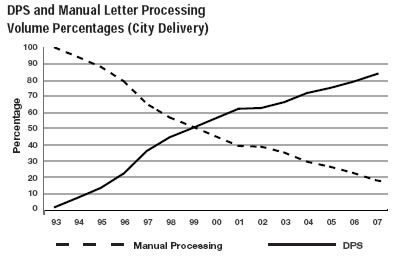Chapter 4 Our Operations
Delivery and Pickup
DELIVERY OPERATIONS
Delivery is the Postal Service’s largest operations function, accounting for approximately 45 percent of salary expenses. Despite an increase of 1.8 million delivery points, Delivery used 3.33 million fewer workhours because of effective growth management, increased use of automation, standardization of best practices, improved productivities, and complement controls.
Growth Management
National deployment of the Delivery Growth Management Tool led to better decisions on how to serve new delivery points. New growth was predominantly served through lower-cost means of delivery. Walking and “park-and-loop” delivery points declined, while curbline, cluster box, and centralized deliveries increased. Growth in lower-cost Rural delivery accounted for more than one-half of all new delivery points. The table below shows the number of delivery points and growth in delivery points by type at the close of 2007.
| Type of Delivery | 2007 | Change from 2006 |
|---|---|---|
| City | 86,882,476 | 590,303 |
| Rural | 38,382,966 | 1,017,106 |
| Post Office box service | 20,184,453 | 78,607 |
| Highway Contract Route | 2,542,627 | 132,310 |
| Total | 147,992,522 | 1,818,326 |
Delivery Productivity Improvement
Delivery Point Sequence (DPS) letter mail eliminates manual sorting of letters by carriers. DPS mail is sequenced by automated equipment earlier in the distribution process and is presented to carriers ready to be taken to the street for delivery. DPS reduces costs, improves accuracy and speed of delivery, and contributes to improved customer satisfaction. More than 99 percent of all City delivery routes and 83 percent of all Rural routes receive DPS letters. On average, these routes receive 86 percent of their letters in DPS. The goal is to raise the DPS percentage to 95 percent by 2010. The graph below shows the growth in DPS mail since 1993 when the program began. Plans are underway to automate flats sequencing starting in 2008.
Improved office and street delivery productivities are keys to increasing delivery efficiency. Delivery office and street productivities both improved in 2007. The AM Standard Operating Procedures (AMSOP) program helps offices comply with standard management practices. Data show significant performance gains in offices that pass AMSOP certification audits. To date, 69 percent of target delivery offices are AMSOP certified.
The Delivery Operations Information System (DOIS) provides front-line supervision with day-to-day workload and performance information at the route level. The DOIS performance platform was expanded to create the City Delivery Pivoting Opportunity Model (CDPOM), a Web-based model that helps align staffing with workload. Organization-wide focus on the use of CDPOM produced unprecedented gains in deliveries per hour (DPH) during the latter half of 2007.

Routes
In City carrier operations, declines in manual workload, improved productivities, and increases in possible deliveries drive the need for route adjustments. By adjusting or consolidating routes, the Postal Service was able to absorb delivery growth without significant increases in routes. As a result, the number of deliveries per route increased to more than 530. The table below shows the increases in average deliveries per City route from 2005 to 2007.
| 2005 | 2006 | 2007 | |
|---|---|---|---|
| Deliveries Per Route (City) | 521.6 | 525.4 | 530.3 |
Rural and highway contract route delivery is less costly than City delivery. The table below shows the number of City, Rural, and highway contract routes and the change in routes since last year. Growth in delivery points drove increases in Rural and highway contract routes.
| FY07 | Change from FY06 | |
|---|---|---|
| City | 163,479 | 67 |
| Rural | 76,390 | 1,453 |
| Highway Contract Route | 10,713 | 256 |
| Total | 250,582 | 1,776 |
PICKUP
Carrier Pickup
Traditionally, carriers have accepted prepaid outgoing mail. Today, customers can submit a free package pickup request online at usps.com to have prepaid Priority or Express Mail packages picked up the next delivery day as part of the carrier’s normal route. The volume of Package Pickup mail grew almost 50 percent as more customers used Click-N-Ship and online postage.